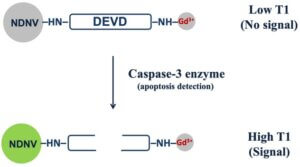Summary
Chemotherapy is limited by the failure to clinically monitor the efficacy of the treatment in real-time, which results in suboptimal chemotherapy being given for a prolonged period. Predicting the outcome of chemotherapy immediately after drug administration can increase diagnostic accuracy, efficacy outcomes, and successful treatment. Quantum nanodiamond sensors can be used as optical sensors and drug delivery probes for chemotherapy. In particular, nanodiamonds containing nitrogen-vacancy (NV) centers can serve as attractive probes for optically sensing chemical reactions and biological processes, thanks to their small size, bio-compatibility, and fluorescent properties of the NV centers. This work focuses on variations in the relaxation time in the nanodiamond NV centers, which change when the nanodiamonds are brought into proximity to Gadolinium (Gd) ions – for example, by using a peptide sequence as a connector between the nanodiamond and a Gd compound – and can be optically monitored. The experiment will investigate one type of action of chemotherapeutic drugs, which is to induce cell death (apoptosis) of the cancer cells. Specific enzymes released during apoptosis can cut the connection between the nanodiamonds and Gd, separating NVs from the Gd and decreasing the relaxation rate. Thus, observing the differences in relaxation rate upon chemotherapy allows the drug’s efficacy to be immediately monitored.

Figure 1. A specific enzyme (Caspase 3) is released in the presence of an effective chemotherapeutic drug, resulting in the separation of nanodiamonds and Gd and decreasing the relaxation rate.
Related Content

Free-space Polarization-selective Microcavity based on Chiral Metasurfaces
Summary Developing a new type of Fabry-Pérot cavity that allows improved control of the atoms’ emission into the cavity mode will result in enhancement of the efficiency and fidelity of quantum state transfer from photons to atoms and back. This in turn can be used to improve the performance of quantum networks and repeaters, as […]
September 19, 2019

Quantum Material Multilayer Photonic Devices and Network
Summary Realizing highly integrated quantum photonic devices on a chip can enable new opportunities for photonic quantum computation. In this project, we explore heterostructures of stacked two-dimensional (2D) materials, such transition metal dichalcogenides (TMDC) or graphene, combined with optical microcavities as a platform for such devices. 2D materials are extremely thin and flexible, and have […]
December 12, 2019

Quantum Simulation of Strongly Coupled Field Theories
Strongly-coupled field theories describe both fundamental and applied quantum problems.
August 10, 2017

Mesoscopic systems as coherent control elements
Summary Mesoscopic systems provide a new tool for quantum systems design. In particular, they are enabling of robust quantum control. Here “mesoscopic system” refers to a connected network where each element, if studied alone, would be a quantum bit. The network is too big to be treated fully quantum mechanically. We do not have individual […]
September 1, 2016

